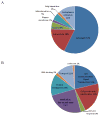Molecular markers of preterm labor in the choriodecidua
- PMID: 20009011
- PMCID: PMC2852874
- DOI: 10.1177/1933719109353454
Molecular markers of preterm labor in the choriodecidua
Abstract
Because relevant biochemical changes are known to begin at the choriodecidual interface some weeks before actual clinical onset of labor, we hypothesized that the preterm choriodecidua may display gene and protein expression patterns specific to preterm labor. Transcriptomic (microarray) and proteomic (2-dimensional gel electrophoresis [2DGE]) profiling methodologies were used to compare changes in choriodecidual tissue collected from women who delivered before 35 weeks of gestation following spontaneous preterm labor (n = 12) and gestation-matched nonlaboring controls (n = 7). Additionally, 2DGE was used to compare differences in protein expression during term and preterm labor and to construct a choriodecidual proteome map. Overall, expressed transcripts and proteins indicated active tissue remodeling independent of labor status and an association with inflammatory processes during labor. Spontaneous, infection-induced and abruption-associated preterm deliveries were each defined by distinct transcriptional profiles. Proteins osteoglycin and progesterone receptor component 2 (PGRMC2) were upregulated during term and preterm labor while galectin 1, annexin 3, annexin 5, and protein disulfide isomerase (PDI) were upregulated only during preterm labor, suggesting a probable association with the underlying pathology. Together, these results represent novel data that warrant further investigations to elucidate plausible causal relationships of these molecules with spontaneous preterm delivery.
Figures




Similar articles
-
Inflammatory cytokine mRNA in human gestational tissues: implications for term and preterm labor.J Soc Gynecol Investig. 1996 Nov-Dec;3(6):328-35. J Soc Gynecol Investig. 1996. PMID: 8923417
-
The expression of parathyroid hormone-related protein mRNA and immunoreactive protein in human amnion and choriodecidua is increased at term compared with preterm gestation.J Endocrinol. 1997 Jul;154(1):103-12. doi: 10.1677/joe.0.1540103. J Endocrinol. 1997. PMID: 9246943
-
Prostaglandin pathway gene expression in human placenta, amnion and choriodecidua is differentially affected by preterm and term labour and by uterine inflammation.BMC Pregnancy Childbirth. 2014 Jul 22;14:241. doi: 10.1186/1471-2393-14-241. BMC Pregnancy Childbirth. 2014. PMID: 25048443 Free PMC article.
-
The use of high-dimensional biology (genomics, transcriptomics, proteomics, and metabolomics) to understand the preterm parturition syndrome.BJOG. 2006 Dec;113 Suppl 3(Suppl 3):118-35. doi: 10.1111/j.1471-0528.2006.01150.x. BJOG. 2006. PMID: 17206980 Free PMC article. Review.
-
Hypothetical role of prostaglandins in the onset of preterm labor after fetal surgery.Fetal Diagn Ther. 2007;22(2):94-9. doi: 10.1159/000097104. Epub 2006 Nov 27. Fetal Diagn Ther. 2007. PMID: 17135752 Review.
Cited by
-
Galectin-1 and Galectin-9 Concentration in Maternal Serum: Implications in Pregnancies Complicated with Preterm Prelabor Rupture of Membranes.J Clin Med. 2022 Oct 27;11(21):6330. doi: 10.3390/jcm11216330. J Clin Med. 2022. PMID: 36362558 Free PMC article.
-
Immune cell and transcriptomic analysis of the human decidua in term and preterm parturition.Mol Hum Reprod. 2017 Oct 1;23(10):708-724. doi: 10.1093/molehr/gax038. Mol Hum Reprod. 2017. PMID: 28962035 Free PMC article.
-
Effect of Steroid Hormones, Prostaglandins (E2 and F2α), Oxytocin, and Tumor Necrosis Factor Alpha on Membrane Progesterone (P4) Receptors Gene Expression in Bovine Myometrial Cells.Animals (Basel). 2022 Feb 19;12(4):519. doi: 10.3390/ani12040519. Animals (Basel). 2022. PMID: 35203226 Free PMC article.
-
Inflammatory gene regulatory networks in amnion cells following cytokine stimulation: translational systems approach to modeling human parturition.PLoS One. 2011;6(6):e20560. doi: 10.1371/journal.pone.0020560. Epub 2011 Jun 2. PLoS One. 2011. PMID: 21655103 Free PMC article.
-
PGRMC1 and PGRMC2 in uterine physiology and disease.Front Neurosci. 2013 Sep 19;7:168. doi: 10.3389/fnins.2013.00168. eCollection 2013. Front Neurosci. 2013. PMID: 24065879 Free PMC article.
References
-
- Bell SC, Malak TM. Preterm Labour. Churchill Livingstone; New York: 1997. Structural and Cellular Biology of the Fetal Membranes; pp. 401–428.
-
- Goldenberg RL, Iams JD, Mercer BM, et al. The Preterm Prediction Study: toward a multiple-marker test for spontaneous preterm birth. Am J Obstet Gynecol. 2001;185(3):643–651. - PubMed
-
- Ramagli LS. Quantifying protein in 2D PAGE Solubilization Buffers. From: Methods in Molecular Biology Vol 112: 2D Proteome Analysis Protocols. 1999:99–103. - PubMed
Publication types
MeSH terms
Substances
Grants and funding
LinkOut - more resources
Full Text Sources
Research Materials

